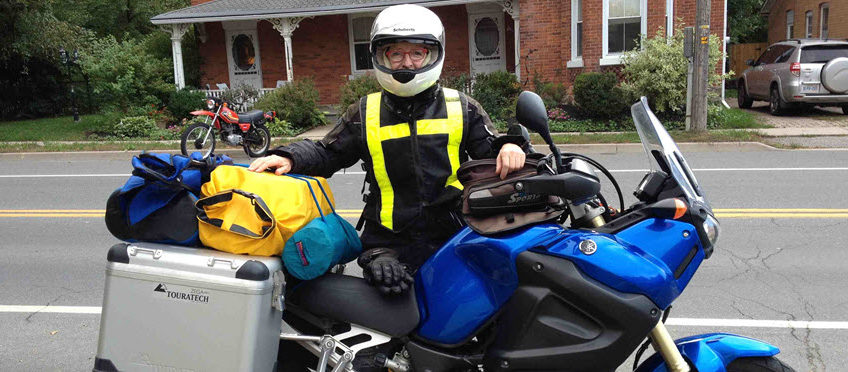Most of my travel across Canada was in warm, but not hot temperatures. The previous few days I’d been riding in temperate conditions along the Pacific Coast Highway.
That day I planned to ride from Fort Bragg, on the coast, via Napa to Clayton, California, where I would stay with friends. It was an easily doable 300 kilometres and even though I was beginning to feel ill, I vowed to make it.
By the town of Napa, three-quarters of the way there, I had to stop. The temperature was over 100°F/38°C, not hot by some standards but too hot for me, especially since I hadn’t had a chance to acclimatize.
Nauseous, disoriented, confused, and very hot, I parked my bike along a curb and stumbled into the lobby of a Chinese Restaurant looking for a place to cool off. With help from local tourism folks, I found an air-conditioned room where I holed up for 36 hours to recover.
It was a frightening experience. What’s more, it was avoidable. It hasn’t happened since.
Practice these 10 tips to help you keep your cool.
- Start right. Before heading out into what you know will be a hot day, make sure you’re well rested and well hydrated. If you’re not feeling well, defer your riding until you’re better. Fatigue, dehydration, and illness make you more susceptible to the effects of heat.
- Stay hydrated. Consume at least one litre per hour while you’re riding. More in hotter temperatures. I carry a two-litre camelback in my tank bag and sip constantly, even with a full-face helmet. Add ice when you fill it. You can also wear it on your back or attach a water canister to your bike that’s accessible during riding. Top up when you stop for rest breaks and make sure you’re carrying extra water in case you’re stranded in the heat.
- Avoid alcohol and caffeine. Alcohol is a diuretic, thus accelerates dehydration. Even if you drink only in the evening, it can leave you dehydrated for your start the next day. The effect of caffeine is debatable so why risk it? Generally, plain water is best.
- Stay covered. Wear an abrasion resistant full-length jacket, pants, gloves, boots, and a full-face or modular helmet to protect you from injury at any time. They’ll also reduce the effects of sunburn and dehydration. Look for gear with lots of vents you can open in hot weather to promote airflow—and make sure they’re open.Your body loses heat by convection, conduction, radiation, and evaporation—when the ambient temperatures are lower than the normal body temperature of 37°C. Good ventilation in helmet, jacket, and pants creates airflow and promotes greater evaporation, keeping you cool.When ambient temperatures rise above body temperature, the only cooling mechanism that works is evaporation, but too much will dehydrate you. Under these circumstances, closing your vents to minimize airflow keeps you cooler and reduces the rate of dehydration.Some people find cooling vests or even neck bandanas effective for staying cool.
- Wear wicking base layers. Long-sleeved shirts and full-length leggings that wick away sweat, are helpful even in extreme temperatures. At lower temperatures they facilitate evaporation and the removal of sweat via airflow. At higher temperatures when vents are closed, the sweat they wick still provides some cooling. They also add comfort and prevent your riding gear from sticking to you.
- Plan your day. Start your day early before it starts to sizzle. Stop in a cool spot during the heat of the day, generally between noon and five p.m. If necessary, continue when it cools off again. Try and allow your body time to acclimatize, gradually increasing your exposure to hot temperatures.
- Take more frequent rest breaks. Use stopping as an opportunity to get off the bike, hydrate, and move around. Take your helmet off and wet your head. Take your boots off and cool your feet. Even better, get into an air-conditioned place where you can cool down.
- Keep your bike cool. Motorcycles generate heat so whatever you can do to keep heat production at a minimum will help keep you cooler too. Make sure your radiator and oil cleaner is free of bugs, dirt, and debris. Clean grime from cooling fins on air-cooled engines so they can do their cooling job. Generally, make sure your fluids are clean, at the appropriate level, and your motorcycle is well maintained.
- Watch for early signs of heat exhaustion. Your body will send signals that it’s having trouble regulating your temperature. These include cramps, nausea, headache, excessive sweating, dizziness, confusion, unusual fatigue, and flushed or pale skin. If you’ve stopped urinating or your urine is very concentrated, that’s a sign you’re dehydrated. If you experience any of these, get off your bike, cool down, and rehydrate.
- Use common sense. Failure to address early signs can lead to the more serious heat stroke. Often, if we’re riding with others, we don’t want to inconvenience them, or we think we can tough it out. It’s more of an inconvenience to end up in the hospital.
Factors such as degree of physical fitness, metabolism, medications, medical conditions, prior heat injuries, age, weight, and degree of acclimatization all affect a person’s sensitivity to heat.
Environmental factors such as radiant heat, like that from engines or road surfaces, air movement, and humidity compound the effect of ambient heat and your body’s ability to deal with it.
Know yourself and follow the steps to prevent heat exhaustion. Make sure you’re familiar with the early signs of trouble. As soon as you notice them, it’s time to pull off the road and recover before proceeding. Otherwise, you’re jeopardizing your health and safety, and your enjoyment of the ride.
© Story and photo by Liz Jansen








Very good information. When all else fails or is not readily available
Line the inside of your jacket with newspaper then take a cold water hose
( usually available at a service station or some kind home owner & run
cold water down ( at the neck) inside your jacket & leathers until your boots
are full. This will save you from heat stroke temporarily. Until you come to a safe place.